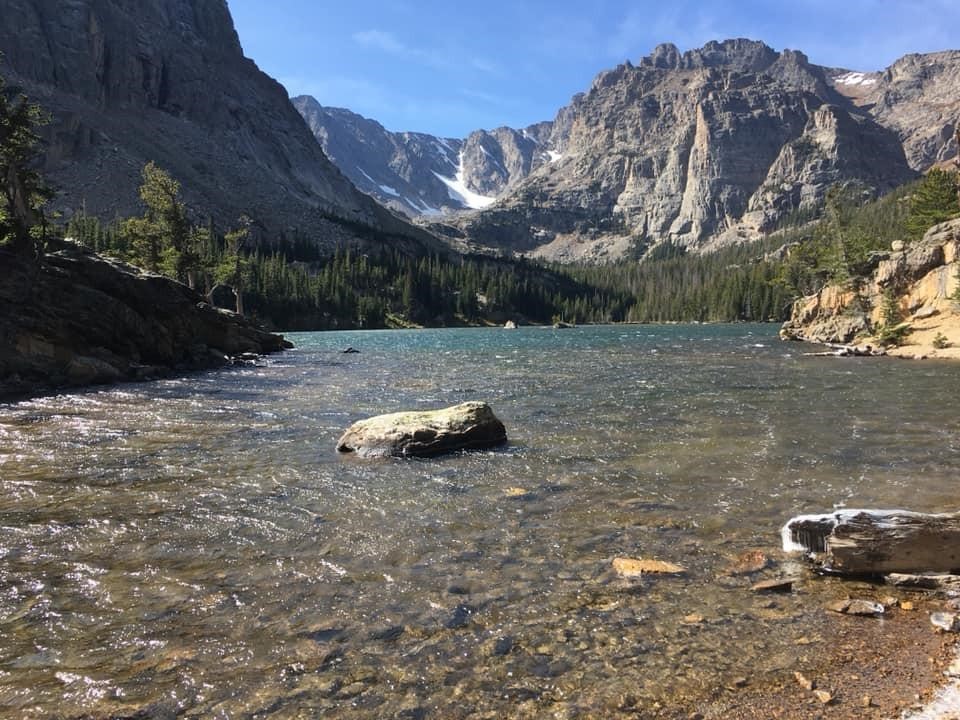by Mary Korte and Ana Mettler, Jefferson County Open School Teachers

The Loch at Andrews Tarn
This past weekend I stood at the bottom of Andrews Glacier in Rocky Mountain National Park staring into Andrews Tarn, an aqua-marine pond filled with melting glacial ice. Though I could not see beyond the surface of the water I was captivated. Further down the gorge the water came to rest in The Loch where it was crystal clear and I could see straight to the bottom. Just like one can not see beyond the surface of Andrews Tarn, so too do our students struggle to see beyond the surface of their own thinking. As the water moves down the mountain it becomes clearer through its encounters with various obstacles before it comes to rest for a time in The Loch. Our students also need time for encounters with others in order to clarify their own thinking.
When I came back to school, my teammate Ana and I reflected on just how critical it is for students to talk in order to clarify their thinking. The practice of “turn and talk” gives students this opportunity. Early on in the school year Ana and I specifically teach routines meant to support students as they learn to engage in productive discourse with each other. This year the title of our anchor chart is “Turn and Talk – Look and Listen.” For many years we created anchor charts that emphasized the speaking part of the Turn and Talk routine without giving equal weight to the importance of supporting students with active listening. Now we are explicitly supporting students with both. When you are listening to your partner how will your partner know that you are listening? What does whole body listening look like? When my partner is done speaking how will my partner know that I have been listening? We model with our students and practice whole body listening.
 As a listener, I know my job is to make eye contact and open my ears and heart to think about what my partner is saying (indeed the little word ear is embedded in the bigger word heart – your ear is the conduit to understanding the heart of your partner). Finally, when my partner is done speaking I paraphrase what has been said. We learn to use the sentence stem, “So you were saying…,” with our students as opposed to “I heard you say…,” in order to accentuate the “you” instead of placing emphasis on the “I.” This sends an implicit message to my partner that what was said is important. Our lessons also give equal weight to supporting student talk. We want our students to engage in discourse that helps them clarify their thinking. In order to do this we know that students need purposeful language to engage with one another. Students practice sharing thinking and responding to one another. A variety of sentence stems support their conversations. “I agree with you because…,” I politely disagree with you because…,” “I am changing my thinking because…” “I am wondering …,” “What else…,” Sentence stems like these help our students learn to explain an idea, share schema with one another, accept that we can change our thinking, and understand that it is ok if we might not always agree. Learning to listen to a variety of perspectives opens up the possibility of constructing new ideas.
As a listener, I know my job is to make eye contact and open my ears and heart to think about what my partner is saying (indeed the little word ear is embedded in the bigger word heart – your ear is the conduit to understanding the heart of your partner). Finally, when my partner is done speaking I paraphrase what has been said. We learn to use the sentence stem, “So you were saying…,” with our students as opposed to “I heard you say…,” in order to accentuate the “you” instead of placing emphasis on the “I.” This sends an implicit message to my partner that what was said is important. Our lessons also give equal weight to supporting student talk. We want our students to engage in discourse that helps them clarify their thinking. In order to do this we know that students need purposeful language to engage with one another. Students practice sharing thinking and responding to one another. A variety of sentence stems support their conversations. “I agree with you because…,” I politely disagree with you because…,” “I am changing my thinking because…” “I am wondering …,” “What else…,” Sentence stems like these help our students learn to explain an idea, share schema with one another, accept that we can change our thinking, and understand that it is ok if we might not always agree. Learning to listen to a variety of perspectives opens up the possibility of constructing new ideas.
As we think about preparing our young students for their responsibility to become engaged citizens in our democracy, we know that explicitly teaching the art of discourse is essential. Just as the glacial water must encounter obstacles before resting in a clear lake, so too must our students have thoughtful encounters with their peers. We can support students with clarifying their thinking by teaching students explicit skills, allowing them to struggle and encounter obstacles, and giving them opportunities to practice in order to see beyond the surface of their own thinking.

